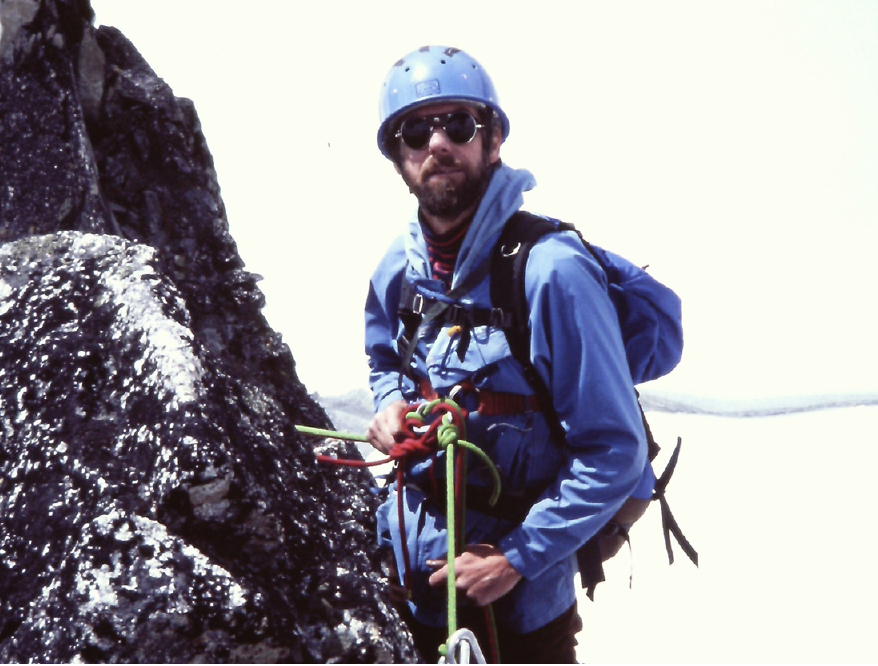Volunteer profile: Helmut Microys, recipient of Honorary Membership in The Alpine Club of Canada
by Paul Geddes
In order to be considered for this high level of recognition by the ACC, one has made an exceptional contribution to Canadian mountaineering. Helmut brought his climbing skills to Canada in 1955 from his home country of Austria. For several decades as a "hardman" in Ontario he established over 120 new routes along the limestone cliffs of the Niagara Escarpment and at Bon Echo, greatly influencing the next generation of local climbers. In his lifetime he climbed more than 700 mountain summits in Canada and Europe. In 1990 Helmut received the ACC Distinguished Service Award.
Helmut Microys belaying on traverse of the Archduke Trio at the 1982 GMC Vowell Glacier Camp. Photo Robert Hall
His route-finding skills are legendary. For Helmut, going to the mountains routinely meant establishing long traverses over multiple summits, travelling light and fast. In 1966 he completed the first recorded solo traverse of the Sir Donald group with a bivi in the Uto/Sir Donald col. In 1972 with long-time climbing partner Michael Rosenberger, the pair carried out two major traverses: Tusk, Irvine, Chettan and Shipton; and Pic Tordu, Cowl and Mount Shackleton. In recent years Helmut enjoyed trips to the Alps where adventurous via ferrata climbs provided a challenge for him.
He left his mark in the St. Elias Mountains during Canada’s 1967 Centennial celebrations. The ACC organized the Yukon Alpine Centennial Expedition. A primary goal was to summit unclimbed mountains named for each province and territory. Microys lead his team to the summit of Mount Ontario (3,720 m).
And while in the area he embarked on his Mount Steele adventure…
Within hours of being dropped off at 3,000 m on the remote Dennis Glacier, one of Helmut’s five teammates, Roly Reader, badly broke both legs in a crevasse fall while descending back to basecamp. In 1967 there was no means of outside communication. Helmut formed a rescue party to seek help — they needed to ski over the summit of Mount Steele (5,073 m), thereby making the fifth ascent of Canada’s fifth highest mountain.
The ACC General Mountaineering Camp which was also taking place in the area had established a helicopter-supplied high camp on the other side of Mount Steele at just under 4,000 m elevation. At the ACC high camp they found their cache plus enough supplies to wait out a three-day storm. When the weather cleared a helicopter arrived to dig out the camp —thus initiating the rescue of Roly. Not wanting to cut a good adventure short, after the rescue Helmut and teammates skied out to Mile-1,064 on the Alaska Highway over the next eight days.
Ron Factor, a climbing partner of Helmut recalls: “I’ve had the pleasure of climbing with Helmut over several decades. The pleasure was derived from more than his superb route finding, climbing expertise, and mentoring. Most importantly, Helmut made sure that everyone on a climb was safe. He understood our individual limitations, roped us up when needed and otherwise coached us when not. He is a man of great culture, education and learning and has an encyclopedic knowledge of fine wines. He has made a significant contribution to climbing in North America and to the lives of those who are privileged to know him.”
Over the years Helmut avoided attention but always had time to give advice to those who asked. A casual comment on one of his bold 1977 first ascents named Harmful Armful at Bon Echo: “This was an all-nut ascent: one nut leading, and one nut following and no pitons in between!”
In meeting rooms internationally, Helmut influenced decisions on climbing safety standards over a period of thirty years (1974 to 2004). His work on the UIAA Safety Commission led to many published articles. A major research project entitled "Climbing Ropes" was published in the 1977 issue of the American Alpine Journal.

